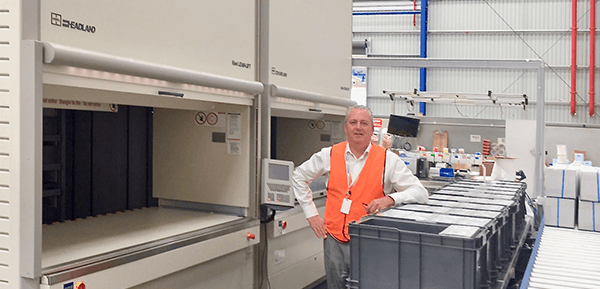This article was originally published on CeMAT.
Vertical Storage Solutions Deliver Efficiency
One of the most challenging and time-consuming hurdles that businesses face in the digital era is making sure that logistical processes – including transportation, distribution, and picking and packing of items – are as efficient as possible. Driving performance improvement across your supply chain takes work, which is why it’s such a challenge for businesses looking to digitise, improve supply chain efficiency, or just increase the capacity of their warehouse.
There is one way to guarantee an improvement in your warehouse efficiency by up to 40% – and it doesn’t involve restructuring your whole supply chain. So, what’s this miracle answer we hear you ask? Vertical storage.
Let’s take a look at a case study on how vertical storage can deliver more efficient processes in your supply chain.
The client:
Whether you’re a small, medium or large enterprise, logistics activities will have a direct impact on your potential for growth. When Astralpool Australia decided to update their warehouses in 2016, they wanted to make sure that the new solutions they implement would allow for the accelerated through-put of their growth.
Astralpool provides equipment for commercial and private swimming pools, and are a local manufacturer of gas heaters, which requires a range of different production methods including moulding, powder coating, metal fabrication and more. Everything is done in-house rather than being outsourced, so they need to ensure delays in delivering their products don’t cut into the bottom line.
Their product range is diverse, and as their business has grown in Australia, it’s easy to see how issues within a logistics network can limit scalability and profitability.
The challenge:
Astralpool has been trading since the 1990s, but when they started manufacturing gas pool heaters, they realised their current storage systems weren’t keeping up with their growth in business. The range of various elements that were introduced into their processes meant they needed to go through a serious overhaul of their facilities to keep up with demand and to make their new product offering didn’t interfere with other areas of the business.
The solution:
In 2016, Astralpool installed two Hänel Lean-Lifts to create a two-fold effect on efficiency; reduce the number of staff required for picking, and reduce the amount of floor space required to fulfil orders.
Astralpool employed the services of Headland Machinery to help build a more efficient warehouse, and not only did they introduce the two Lean-Lifts, but they combined the storage solution with MultiPick software that allows for high-speed and reliable picking.
The result:
What people reading this article are most interested in hearing about: what efficiencies did Astralpool gain? The introduction of their vertical storage system improved picking efficiency by 40%. There were also improvements in productivity as the number of employee required in that department were reduced from six to 1, which mean staff could be placed in other areas of the warehouse.
So why is vertical storage such a great fit for warehouses? Let’s take a look at the theory behind them.
New warehouses don’t need to be bigger. They need to be smarter.
As your business grows, it’s easy to assume that you’ll also grow out of your warehouse. But this isn’t always the case. If business is growing rapidly, process optimisation should always be at the forefront of any strategic decisions made. When optimising your warehouses storage capacity, there are variety of reasons you should reference vertical space over horizontal floorspace. The two most popular types of vertical storage systems are:
Vertical lifts
If you read our post on how warehouse management software, then you should know all about the benefit of shifting from a manual to an automated facility. This is known as a goods-to-man warehouse, and is the underlying principle that’s changing the way warehouses all over the world are operating.
Vertical lifts are automated storage and retrieval systems that generally feature some form of an elevator that can climb along the storage tower to deposit and retrieve pallets or draws. These structures often require high ceilings, but deliver savings on the overall footprint of a DC.
Vertical carousels

Vertical carousels are often automated, and are slightly different to lifts because – rather than an elevator like structure moving up to retrieve the items – the carousel shifts to bring the item to the front where it can be accessed.
If you have all the warehouse space in the world and don’t need to worry about capacity, then stop reading here. But if you’re one of the majority of businesses out there that are increases the amount of smaller sized warehouses and DCs, then this post is for you. Transitioning from a horizontal storage system to a vertical system may seem like a big business decision to make. However, the benefit-to-cost ratio is significantly improved when comparing operations in an inherently inefficient warehouse.
Not only do vertical storage solutions help you save space, but they improve productivity, inventory access and movement, all while helping to reduce the amount of stooping, reaching and heavy lifting traditionally required by operators.
Visit Headland Storage or read more for a full range of vertical storage solutions.

